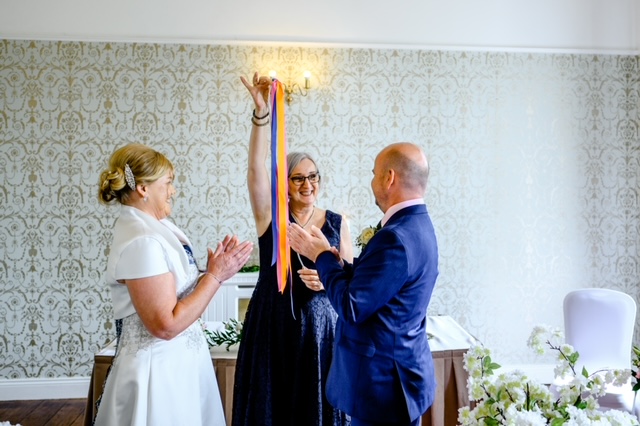Handfasting

"Celtic handfasting ceremonies can be a beautiful and meaningful way for couples to celebrate their love and commitment to each other. Whether they are drawn to the ancient roots of the ceremony, or simply appreciate the spiritual symbolism and personal significance of the ritual, handfasting can be a powerful way for couples to mark the beginning of their journey together."
Handfasting Ritual - It's history and modern day useage
Celtic handfasting is a traditional form of marriage ceremony that has its roots in Celtic culture. It was a common practice in Ireland, where it was used as a way of joining two people together in marriage without the need for a formal church ceremony. Today, Celtic handfasting has been revived as a popular alternative to traditional wedding ceremonies, with many couples choosing to incorporate elements of this ancient practice into their modern-day weddings.
The origins of Celtic handfasting can be traced back to the pre-Christian era, when marriages were often arranged between families or clans. In these early times, handfasting was seen as a temporary commitment that could be dissolved after a period of time. It was a way for couples to test their compatibility before entering into a more permanent union.
During the Middle Ages, the practice of handfasting continued to be popular in Celtic regions, although it began to take on a more formalized structure. Couples would come together in front of witnesses and make their vows to each other, binding their hands together with ribbons or cords to symbolize their commitment. In some cases, the handfasting ceremony was followed by a church wedding, which made the union legally binding.
With the arrival of Christianity, handfasting began to lose its popularity as a marriage ceremony, as the church began to assert its authority over the institution of marriage. However, the practice continued to be used in rural areas, where the church had less influence, and where couples could not afford the cost of a church wedding.
In recent years, Celtic handfasting has enjoyed a revival as a popular alternative to traditional wedding ceremonies. Many couples are drawn to the ancient symbolism and spiritual significance of the ceremony, which they feel reflects their own personal beliefs and values. The ceremony can be adapted to suit the needs and preferences of the couple, and can be as simple or elaborate as they wish.
Modern-day Celtic handfasting ceremonies typically involve the binding of the couple's hands together with ribbons or cords, which are tied in a series of knots to symbolize the promises and commitments they are making to each other. The ceremony may be conducted in a variety of settings, from a simple outdoor ceremony in nature, to a more formal indoor setting such as a hotel or similar venue.
The ceremony may be conducted by a religious or spiritual leader, or by a non-denominational officiant, or friend. The couple may choose to incorporate traditional Celtic music and poetry into the ceremony, or to include readings and prayers from their own spiritual traditions.
One of the most important aspects of the Celtic handfasting ceremony is the exchange of vows between the couple. These vows may be written by the couple themselves, or they may choose to use traditional Celtic vows that have been passed down through the generations. The vows typically express the couple's love, commitment, and willingness to support and care for each other through all the ups and downs of life.
Another aspect of the ceremony can be the symbolic breaking of the handfasting cord or ribbon. This is done at the end of the ceremony, and symbolizes the release of the couple from their temporary commitment to each other, and their entry into a more permanent union.
Celtic handfasting ceremonies can be a beautiful and meaningful way for couples to celebrate their love and commitment to each other. Whether they are drawn to the ancient roots of the ceremony, or simply appreciate the spiritual symbolism and personal significance of the ritual, handfasting can be a powerful way for couples to mark the beginning of their journey together.
In conclusion, Celtic handfasting is an ancient marriage ceremony with roots in Celtic culture. It has evolved over time, but has retained its spiritual and symbolic significance, and is now enjoying a revival as a popular ritual in many Irish wedding ceremonies.